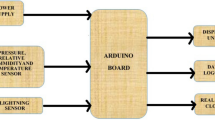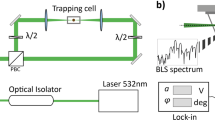Abstract
DURING the last year we have maintained in continuous action an apparatus for recording the electric charge on individual drops of rain. A drop of rain in order to have access into the insulated receiver has first to pass through a fixed but adjustable cylindrical opening of average diameter 1.4 cm. and then through a second opening of diameter 2.4 cm. at the periphery of a rotating disc. Both openings are provided with trap arrangements so that a drop striking the sides is caught and led away. The period of rotation of the disc is so adjusted that with moderate intensity of rain a second drop may not enter into the receiver until the charge of the first has been recorded and the system earthed by an automatic device. A glass manometer of very fine bore is attached to the receiver and keeps a record of the size and number of drops.
This is a preview of subscription content, access via your institution
Access options
Subscribe to this journal
Receive 51 print issues and online access
$199.00 per year
only $3.90 per issue
Buy this article
- Purchase on Springer Link
- Instant access to full article PDF
Prices may be subject to local taxes which are calculated during checkout
Similar content being viewed by others
Author information
Authors and Affiliations
Rights and permissions
About this article
Cite this article
BANERJI, S., LELE, S. Electric Charges on Rain Drops. Nature 130, 998–999 (1932). https://doi.org/10.1038/130998b0
Issue Date:
DOI: https://doi.org/10.1038/130998b0
This article is cited by
-
The characteristics of rain electricity in Nigeria. I — Magnitudes and variations
Pure and Applied Geophysics PAGEOPH (1980)
-
Electricity of thunderstorms
Proceedings of the Indian Academy of Sciences - Section A (1952)
Comments
By submitting a comment you agree to abide by our Terms and Community Guidelines. If you find something abusive or that does not comply with our terms or guidelines please flag it as inappropriate.



